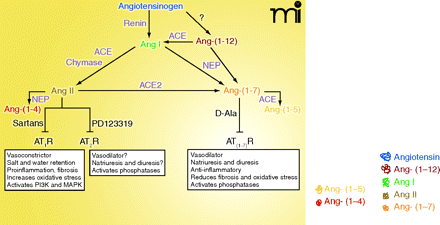
- Institution: Stanford Univ Med Ctr Lane Med Lib/Periodical Dept/Rm L109
- Sign In as Member / Individual
Future Directions in Cardiovascular Pharmacology: Examples from the Renin-Angiotensin System

Schematic of the enzymes and processing of substrates for the renin-angiotensin system. Ang II is formed through the actions of angiotensin converting enzyme (ACE). Ang-(1-7) can be formed through several enzymatic reactions: 1) proteolytic cleavage of Ang I or Ang-(1-12)––a proteolytic cleavage product of angiotensinogen––by neprilysin, or 2) proteolytic cleavage of Ang II by ACE2. Note that neprilysin and ACE2 inactivate Ang II, whereas ACE inactivates Ang-(1-7). Thus, there is reciprocal down-regulation of the opposing peptide by the enzymes responsible for producing each peptide. Each peptide acts on its own distinct receptors (see white text boxes), with the Ang II type 1 receptor (AT1R) mediating the majority of the pro-hypertensive actions of Ang II and the Ang-(1-7) receptor activating pathways that serve as physiologic antagonists to the actions of Ang II. The actions of the AT2R are not yet clear, although several effects of PD123319 mimic the actions of Ang-(1-7). ACE, angiotensin converting enzyme; ACE2, angiotensin converting enzyme 2; NEP, neprilysin; AT1R, AT1 receptor; AT2R, AT2 receptor; AT(1-7) R, Ang-(1-7) receptor, also known as Mas; Sartans, AT1R antagonists, losartan class; PD123319, AT2R antagonist; D-Ala, D-Ala7-Ang-(1-7), the Ang-(1-7) receptor antagonist; PI3K, phosphoinositide 3-kinase; MAPK, mitogen-activated protein kinase.


